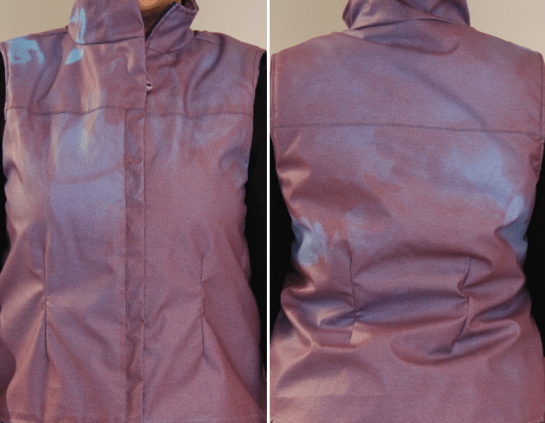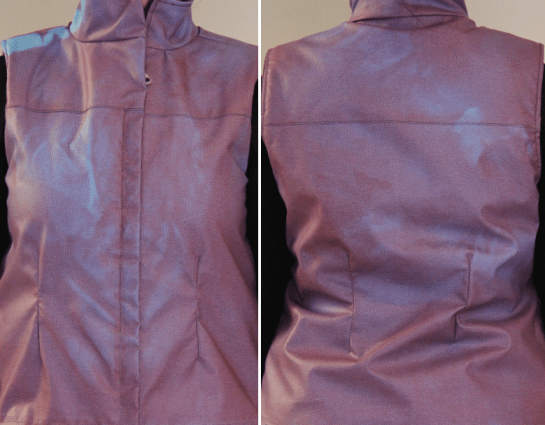Hug Prints: Thermochromic Vest Test and Reflections on Human Contact
I’m a hugger. I can’t help it. When I see a friend, I just go for it without thinking.
There are perfectly good explanations for this. I was raised in the Philippines, land of extremely happy and friendly people. I also grew up with a lot of stuffed animals. I still sleep with a pillow I’ve had with me from the crib—it’s the only material possession that has been with me forever. And dang it, it feels good. Hugging releases oxytocin, the hormone that promotes love and trust.
But I do realize that not all people like to hug others. The idea of touching as a greeting is largely cultural, and I’ve had to adapt accordingly, depending on where I’ve lived and whom I was interacting with. In the Philippines, I hugged. In Spain, I kissed (both cheeks). Here in America, I shake hands. It is especially in the latter that I’ve felt that people respond the least positively to hugs. Many people, I’ve observed, have an invisible “wall” that illustrates their personal space. Touch may be considered as an intrusion, an interruption, or a threat. On the other hand, a hug can also be a sign of great physical intimacy that is only reserved for one’s closest family and friends.
I wanted to investigate our perception of touch. In the past week, I’ve designed a vest made out of thermochromic fabric, which my dear friend and fashion designer Kate Russell expertly sewed. The purple color changes to blue at higher temperatures; if you touch it, your hand will leave a print. The color will change back to purple when the temperature is lowered again.
For this project, I’ve used it as a social experiment of a sort; I’ve initiated a “hug session” in the studio here in SVA’s interaction design department and hugged my fellow grad students. The goal was to find out where their impressions, or “hug prints” would lie, as well as to observe how they would interact with me while wearing a vest that was responsive to their touch. I’ve known these participants for at least a year, and we’ve shared hugs before.
While investigating materials, I noted that people’s skin responded differently to the fabric; some were very “warm” and immediately changed the color of the fabric. Others were “colder” and barely made any difference when they touched it. How much or how little the fabric changes also depends on what the person was doing right before. This made me expect diverse levels of color change.
The hug session was conducted in the studio on the same afternoon; hence the environmental temperature was the same. The participants had also been in the studio for some time; no one was “warmer” than others because of being outdoors.
The experiment was simple. Each person hugged me, and the front and the back of the vest were photographed right after each hug. The vest was returned to its normal (purple) color by sticking it for a few seconds in the freezer and afterwards letting it reach the studio temperature.
For this session, there were seven willing huggers and here are the impressions they left.
Tina was extremely warm and left the darkest prints. The two of us tend to hug in the studio on a regular basis, so familiarity definitely played a role here. It also seemed as though she wanted to make her prints darker, as she hugged me the longest.
It seems obvious that one’s personality reflects how he touches, yet I am still taken by surprise during projects like these. My friend Min Seung is one of the most composed people I know. His hand print on the right looks radically different from the others, because it’s the area surrounding the fingers that turned blue instead. In the beginning, I hesitated because he doesn’t usually hug people yet was willing to help out with the project. (Thanks, Min Seung!)
Shanshan had this interesting impression on the front. (Doesn’t that look like an arrow pointing down?) It almost felt like she was drawing on the vest.
JoonSeo’s was interesting because when hugging, she wrapped both arms underneath, unlike the others who usually had one hand over one of my shoulders and the other one at my waist.
Tony left these moderate impressions.
Chris, who sits next to me in the studio, pretended to be grumpy and growled, “How many times do I have to hug you every day?” His imprints, which were mild, seemed aligned with his quiet personality.
This idea of “epidermal warmth” being related to personality and temperament also seems applicable to Prachi, who is one of the most poised and calm people in the studio.
At the end of the session, I had two conclusions:
1. A responsive garment made people pay attention to the act of hugging in the sense that they had the feedback of the vest to observe after the hug. In normal circumstances, people would just hug and then carry on. Here I felt that they were aware of the vest’s thermochromism, and thus affected the pressure and duration of the hug.
2. Having a garment that responds to touch can make the person want to hug the wearer more. But it can also turn people away; I had an incident where the person refused to hug (I was a sad puppy), even though we’ve hugged on other, more informal, occasions. I suspect that if I kept doing this, I would encounter people who would not like the idea of calling out this particular interaction.
There are two directions in which I can take this project:
1. Investigate how this vest can affect specific relationships, such as parent and child, or husband and wife, etc.
2. Investigate how this can play out with strangers in public spaces.
In any case, I have a lot of hugging to do.
Thank you to my huggers! Also a big thank you to interaction designer and ace photographer Prachi Pundeer, who very patiently took all the photos (except when she hugged me) and waited while we let the vest cool in the freezer for the color to return back to normal.










haha, i wasn’t even thinking of going for the darkest print… it’s just that i never want to come out of a catherine hug!
Pingback: The Daddy Vest: Hugging and Parenthood « The Perceptionalist
Pingback: How It Rolled: TEDxNewHaven Experience Design « The Perceptionalist
Pingback: TEDxNewHaven Experience Design: Happiness and the Senses « The Perceptionalist
Pingback: TEDxNewHaven Experience Design: Happiness and the Senses « DrawHappy